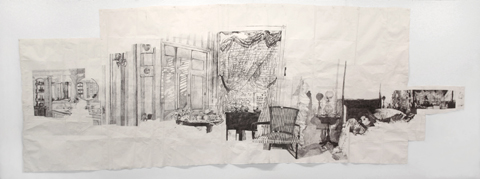
IMMERSIVE Clements's 'Mrs. Jessica Drummond.' |
“I did everything in the world to keep this from happening,” exclaims the assistant to the rich man in Kerry Tribe’s There Will Be ____. The half-hour-long video — on view in the three-person show “Brown University’s 250th Anniversary Alumni Exhibitions” at the school’s Bell Gallery (64 College St, Providence, through March 30) — is an engaging whodunit.
The subject is the infamous 1929 deaths of the two men at the Greystone Mansion in Beverly Hills — the son of an oil tycoon who lived there and his male assistant. It’s often been described as a murder-suicide.
Filming at the mansion “in the very rooms where the killings took place,” Tribe melodramatically plays out possible scenarios with actors in handsome period attire. Is it the mutual suicides of a gay couple? Or was the gay couple murdered by the wealthy man’s angry wife? Could it have been a mob hit made to look like a suicide? Or maybe various people conspired to tamper with the crime scene to throw police off the scent and lessen the scandal for the family?
Tribe’s video Bibliography (Greystone), which screens in an adjoining gallery, reveals that the first video was constructed from dialogue snipped from other movies filmed at the mansion — The Big Lebowski, Spider-Man, There Will Be Blood, Eraserhead, and one of the Garfield cartoons. It’s a neato post-modern maneuver, though not apparent in the first film, and doesn’t really add meaning.
Inevitably, Akira Kurosawa’s Rashomon comes to mind. In that landmark 1950 film, four characters give contradictory accounts of a murder. Which account, if any, is true, remains murky. But the various testimonies probe the psychologies of the characters — and our own reactions to them.
Tribe, who is known for making art about the fugitive nature of memory, doesn’t dig so deeply. Each scenario could be true, or none of them could be true. It’s not about illuminating people or the events, really, but about the intellectual game of throwing out various theories. It’s about luxuriating in mysteries.
The artists in the “Alumni Exhibitions” (a second one is scheduled for April) are grouped because they all attended Brown, not because of similar themes. But, coincidentally, Dawn Clements also touches on Hollywood in her 24-foot-wide pen drawing Mrs. Jessica Drummond(My Reputation, 1946), inspired by Barbara Stanwyck in the 1946 film My Reputation, about a lonely widow struggling with her grief. The power of the piece is in its immersive panoramic view across cabinets and lamps, curtains, and shutters, to a bed where a woman lies staring up at the ceiling.
Paul Ramirez Jonas’s sculpture The Commons is a copy of a statue of Marcus Aurelius on horseback that has stood on Brown’s campus for more than a century. As a democratic gesture, the artist removes the Roman emperor and recreates the horse and pedestal in cork to invite people to use it as a bulletin board. It’s sort of anticlimactic that this sculpture, impressively filling the building’s lobby, is tacked with the usual signs you see around campus — invites to a dance party or Women’s History Month events, someone seeking help finding a lost hat. But I’m reminded of an old AS220 position paper, which emphasized that communities need places to share messages to help fresh ideas percolate.